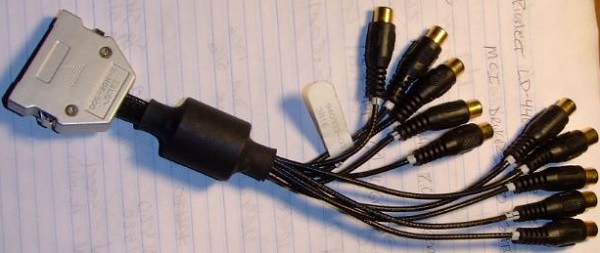|
@704E.ADF VCA/A adapter
(NTSC composite) Video
Capture Adapter base Card Video Capture Adapter Base Card 
TARAM - Translation Address Ram Video Capture Daughter Card 
CA3306E 6-Bit, 15 MSPS, Flash A/D Converter TDA2595 Horizontal combination VA2706DJ Virtual Training Co Inc :: Dual General Purpose Op Amp - SR 42V/us,Io +/-50mA MC1377FN Video Decoder-Encoder Circuit - RGB/NTS encoder TDA3330 TV Color Processor Video Capture Adapter/A o Enables user to capture high quality, photo-like images o Full frame capture from motion video in 1/30 seconds o Images can be manipulated and used in high quality presentations created with the AVC o Uses RGB, NTSC (Composite Video) and Y/C (Super VHS) o Captures 65,536 colors with a resolution of 640 X 480 X 16 bits o Allows viewing live video during capture; the card is not required for general image presentation purposes o 614Kb dual-ported video RAM buffer o Image display modes live, memory, overlay, transparent, pixel The Video Capture Adapter/A provides the
capability to capture, display and digitize high quality
video images for use in presentations and applications
with the Personal System/2 family models. The
adapter supports image capture with the PS/2 Models 50,
55 SX, 60, 70 and 80 and is intended for use with the
AVC licensed program. 2. A Primary I/O Cable which has ten separate cables which end in RCA sockets, with a 20-pin connector on the other end. (For the VCA/A PAL adapter this is a Primary I/O cable with twelve separate cables which end in RCA sockets, with a 37-pin connector on the other end.) 3. A S-Video Output Cable which is also used by the diagnostic program for a Y/C Wrap Cable. This cable has an S-Connector at one end and two RCA plugs at the other end. The BLACK RCA plug is the LUMA (Y) cable and the RED is the CHROMA (C) cable. (This cable is not included with the VCA/A PAL adapter. The VCA/A PAL adapter has two extra cables on the Primary I/O cable which serve as LUMA and CHROMA output connections.) 4. Three 75 Ohm Terminators. 5. A short cable with RCA plugs at both ends which is used by the diagnostic program in Wrap Tests for RGB and Composite Video. (There are two of these cables supplied with the VCA/A PAL adapter.) 6. The diskette which has this README.DOC file, the diagnostic program and related modules, and two Adapter Definition Files (ADF). @704E.ADF is used during the CONFIGURATION step in the installation of the VCA/A adapter (NTSC composite). @70CE.ADF is used during the CONFIGURATION step in the installation of the VCA/A PAL adapter (PAL composite). VCA/A NTSC and PAL
AdapterId 0704Eh "Video Capture Adapter/A"Video Storage Address Select System memory addresses dedicated to this adapter. D4000 to DBFFF or D8000 to DFFFF is recommended. At least 2 16k blocks are recommended for card memory to card memory operations. If another choice must be made, try to use a selection with the most pages. The protect mode selection may be used if your operating system supports 'protect mode' such as OS/2. DOS does not support 'protect mode'." <"C0000-C3FFF">, D0000-DFFFF, D4000-DBFFF, D8000-DFFFF, D0000-D3FFF / D8000-DBFFF, D0000-D3FFF / DC000-DFFFF, D4000-D7FFF / DC000-DFFFF, D0000-D3FFF / CC000-CFFFF, D0000-D3FFF / C0000-C3FFF, D4000-D7FFF / C0000-C3FFF, D4000-D7FFF / CC000-CFFFF, D8000-DBFFF / C0000-C3FFF, D8000-DBFFF / CC000-CFFFF, CC000-CFFFF, D8000-DBFFF, F60000-FFFFFF / CC000-CFFFF NOTE: Green addresses are two 16k windows
|
